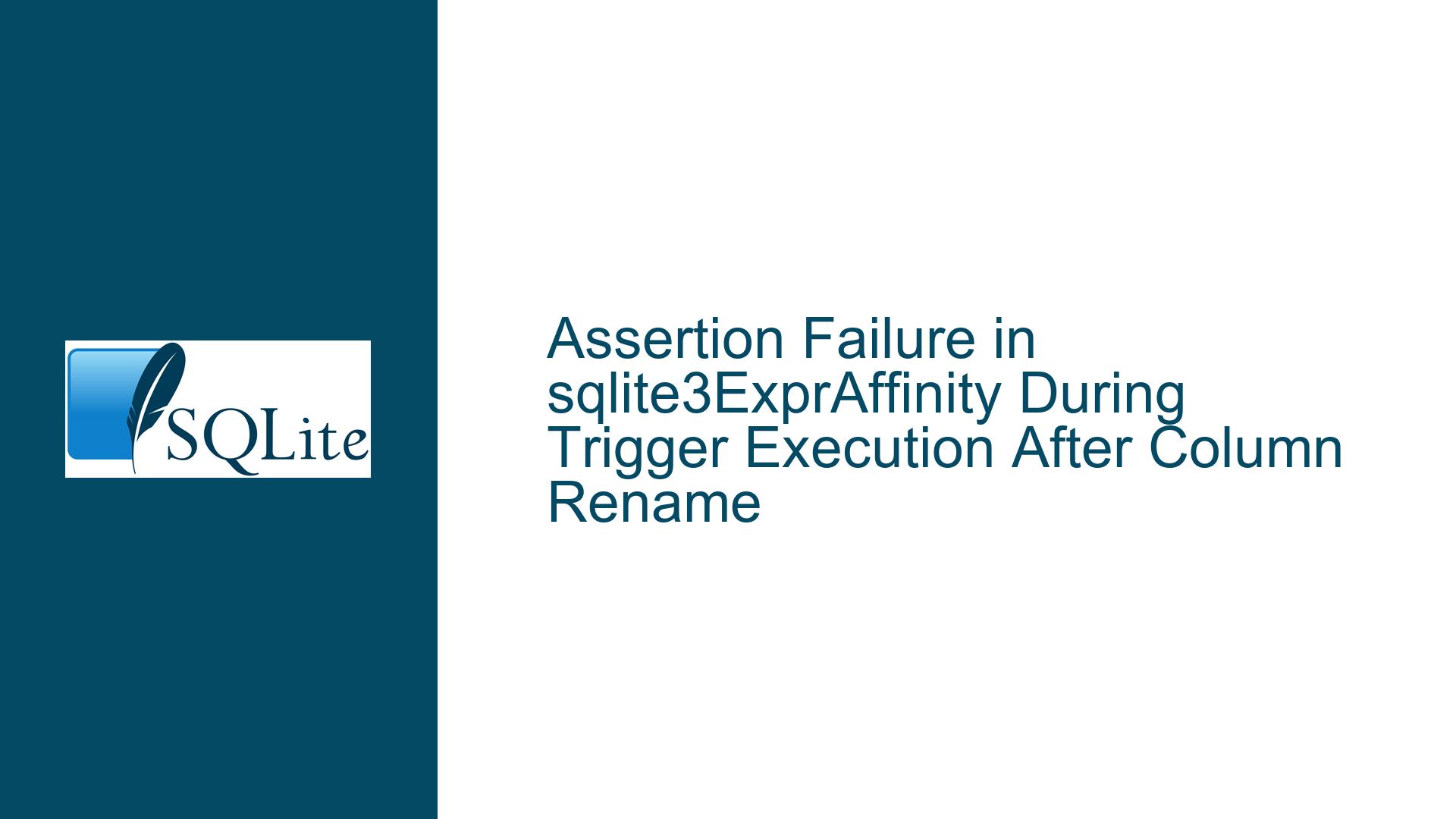Assertion Failure in sqlite3ExprAffinity During Trigger Execution After Column Rename
Understanding the Assertion Failure in sqlite3ExprAffinity
The core issue revolves around an assertion failure in the sqlite3ExprAffinity function, which occurs during the execution of a trigger after renaming a column in a table. The assertion failure is triggered by a specific sequence of SQL operations: creating two tables (v0 and v1), defining a trigger (t) on v0, and then renaming a column in v0. The failure manifests when the trigger is executed, leading to an abrupt termination of the SQLite process with an assertion error.
The assertion failure message indicates that the condition pExpr->iTable == pExpr->pLeft->x.pSelect->pEList->nExpr is not met. This condition is part of SQLite’s internal validation logic, ensuring that the expression’s table index (iTable) matches the number of expressions in the select list (pEList->nExpr) of the left-hand side of the expression. When this condition fails, it suggests a mismatch or inconsistency in the internal representation of the SQL expression tree, likely caused by the column rename operation.
The issue is reproducible with a minimal set of SQL statements, making it easier to isolate and analyze. The bisecting results point to a specific commit range (53fbc269ddbabc4a to f56473f9cc1b476b) where the problem was introduced, providing a clear starting point for debugging. The compilation flags used (-g -O0 -DSQLITE_DEBUG, etc.) enable detailed debugging and tracing, which are essential for diagnosing the root cause.
Exploring the Root Causes of the Assertion Failure
The assertion failure in sqlite3ExprAffinity can be attributed to several potential causes, each related to the internal handling of SQL expressions, triggers, and schema modifications in SQLite. Below, we delve into the most plausible explanations.
1. Inconsistent Expression Tree State After Column Rename
The column rename operation (ALTER TABLE v0 RENAME COLUMN c1 TO c) modifies the schema of table v0. This change may not be fully propagated to the internal representation of the trigger’s SQL expression tree. Specifically, the trigger references c1 in its definition, but after the rename, c1 no longer exists. SQLite may fail to update the expression tree to reflect this change, leading to an inconsistency between the table index (iTable) and the select list (pEList->nExpr).
2. Trigger Compilation and Execution Context
Triggers in SQLite are compiled into bytecode and executed within a specific context. When a column is renamed, the trigger’s bytecode may still reference the old column name (c1), causing a mismatch during execution. The assertion failure suggests that the expression tree used during trigger execution does not align with the updated schema, resulting in an invalid state.
3. Internal Expression Affinity Handling
The sqlite3ExprAffinity function is responsible for determining the affinity of an SQL expression. Affinity refers to the type of data that a column can hold (e.g., text, integer). The assertion failure indicates that the function expects the table index (iTable) to match the number of expressions in the select list (pEList->nExpr). This expectation may be violated if the expression tree is not properly updated after the column rename, leading to an invalid affinity calculation.
4. Impact of Compilation Flags
The compilation flags used (-DSQLITE_DEBUG, -DSQLITE_ENABLE_TREETRACE, etc.) enable additional debugging and tracing features in SQLite. While these flags are useful for diagnosing issues, they may also expose edge cases or internal inconsistencies that would otherwise go unnoticed. The assertion failure could be a side effect of these flags, highlighting a latent issue in the code.
Diagnosing and Resolving the Assertion Failure
To address the assertion failure, we need to systematically diagnose the issue and implement appropriate fixes. Below, we outline the steps to troubleshoot and resolve the problem.
1. Reproducing the Issue in a Controlled Environment
The first step is to reproduce the issue in a controlled environment using the provided SQL statements and compilation flags. This involves creating the tables (v0 and v1), defining the trigger (t), renaming the column (c1 to c), and executing the trigger. By reproducing the issue, we can confirm its validity and gather additional diagnostic information.
2. Analyzing the Expression Tree
Using the -DSQLITE_ENABLE_TREETRACE flag, we can trace the internal representation of the SQL expression tree before and after the column rename. This trace will help us identify any inconsistencies or mismatches in the expression tree, particularly in the pExpr->iTable and pEList->nExpr values. By comparing the expression tree states, we can pinpoint where the inconsistency arises.
3. Updating the Trigger’s Bytecode
After renaming the column, the trigger’s bytecode may still reference the old column name (c1). To resolve this, we need to update the trigger’s bytecode to reflect the new column name (c). This can be achieved by recompiling the trigger after the column rename operation. SQLite provides the sqlite3_recompile function for this purpose, which can be invoked to regenerate the trigger’s bytecode.
4. Validating Schema Changes
SQLite’s schema modification operations, such as ALTER TABLE, should ensure that all dependent objects (e.g., triggers, views) are updated to reflect the changes. In this case, the column rename operation should trigger a revalidation of the trigger’s SQL expression tree. If this revalidation is not occurring, we may need to manually trigger it by dropping and recreating the trigger after the column rename.
5. Fixing the Assertion Condition
The assertion failure occurs because the condition pExpr->iTable == pExpr->pLeft->x.pSelect->pEList->nExpr is not met. To fix this, we need to ensure that the expression tree is correctly updated to reflect the new schema. This may involve modifying the sqlite3ExprAffinity function to handle cases where the table index and select list count do not match, or updating the expression tree to align with the new schema.
6. Testing and Validation
After implementing the fixes, we need to thoroughly test the changes to ensure that the assertion failure no longer occurs. This involves running the original SQL statements, as well as additional test cases to verify the robustness of the solution. We should also test the changes with different compilation flags to ensure compatibility.
7. Contributing the Fix to SQLite
If the issue is confirmed to be a bug in SQLite, the next step is to contribute the fix to the SQLite project. This involves submitting a patch with the necessary code changes, along with a detailed explanation of the issue and the proposed solution. The patch should include test cases to verify the fix and prevent regressions in future releases.
By following these steps, we can systematically diagnose and resolve the assertion failure in sqlite3ExprAffinity, ensuring that SQLite handles column renames and trigger execution correctly. This approach not only addresses the immediate issue but also contributes to the overall stability and reliability of SQLite.






